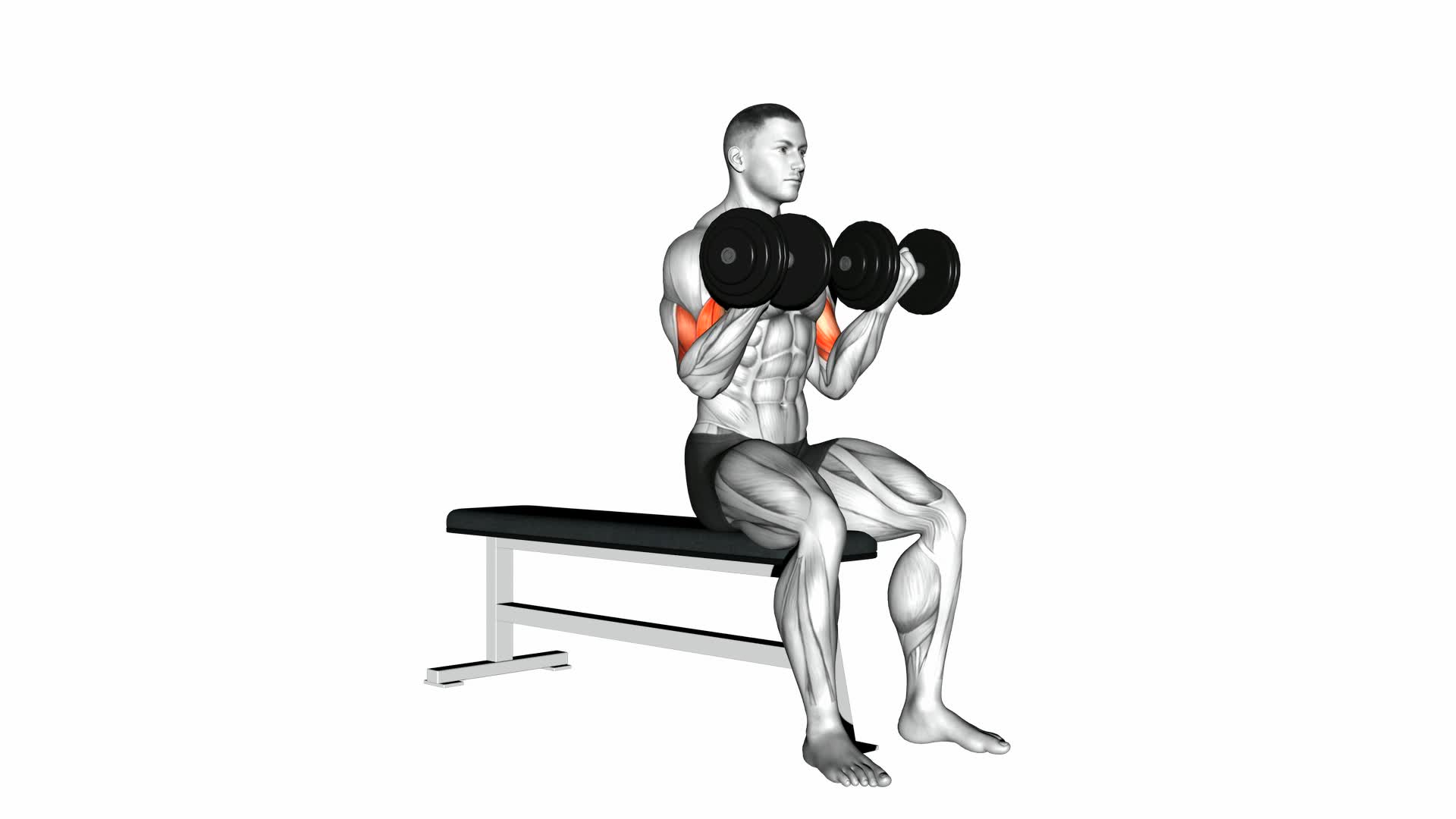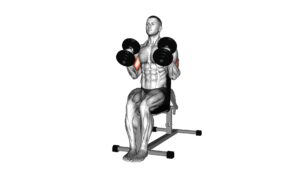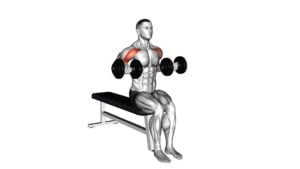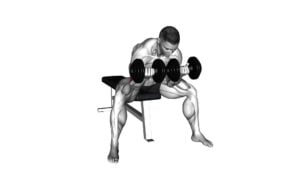Dumbbell Seated Curl – Video Exercise Guide & Tips

Looking to tone your biceps? The dumbbell seated curl is the exercise for you.
Watch This Exercise Video
In this video guide, we'll show you the proper form and technique to get the most out of this exercise.
You'll also learn how to choose the right weight and discover variations to keep your workout challenging.
Avoid common mistakes and maximize your results with our helpful tips.
Get ready to feel the burn and achieve those sculpted arms you've always wanted.
Key Takeaways
- Dumbbell Seated Curl is highly effective for improving bicep strength and promoting muscle hypertrophy.
- It targets the biceps brachii, the muscle responsible for flexing the elbow joint.
- Engaging in Dumbbell Seated Curl increases the overall strength and size of the biceps, enhancing arm aesthetics and providing functional benefits.
- Proper form and technique, such as keeping elbows stationary, maintaining neutral wrist alignment and grip, and squeezing the biceps at the top of the curl, are crucial for maximizing the effectiveness of the exercise.
Benefits of Dumbbell Seated Curl
To maximize your gains from the dumbbell seated curl, it's important to understand the benefits that this exercise offers.
The dumbbell seated curl is a highly effective exercise for improving bicep strength and promoting muscle hypertrophy. By targeting the biceps brachii, the muscle responsible for flexing the elbow joint, this exercise helps to increase the overall strength and size of your biceps.
One of the primary benefits of the dumbbell seated curl is improved bicep strength. As you perform this exercise, your biceps are forced to work against resistance, which stimulates muscle fibers and promotes growth. Over time, this leads to increased strength and allows you to lift heavier weights during other exercises.
In addition to improved strength, the dumbbell seated curl also promotes muscle hypertrophy. By consistently challenging your biceps with progressively heavier weights, you can stimulate muscle growth and increase the size of your biceps. This not only enhances your overall arm aesthetics but also provides functional benefits, such as improved lifting and pulling capabilities.
Understanding the benefits of the dumbbell seated curl is essential for maximizing your gains. However, to fully reap these benefits, it's important to learn and practice proper form and technique.
Proper Form and Technique
To perform the dumbbell seated curl with proper form and technique, it's important to focus on a few key points.
First, make sure to keep your elbows stationary and close to your sides throughout the movement. This will help isolate the bicep muscles and prevent unnecessary strain on the joints.
Additionally, avoid using swinging momentum to lift the weights and instead use controlled, smooth movements for maximum effectiveness.
Lastly, pay attention to your wrist alignment and grip, making sure to maintain a neutral position to avoid any discomfort or injury.
Elbows and Positioning
Position your elbows between your thighs and hold the dumbbells with a neutral grip. This is the proper starting position for the seated curl exercise.
Here are some key tips to ensure you maintain proper elbow position and technique throughout the exercise:
- Keep your upper arms stationary: Avoid swinging your arms or allowing your elbows to move forward or backward. This ensures that the targeted muscles, the biceps, are fully engaged.
- Maintain a stable core: Sit tall and engage your core muscles throughout the exercise. This will help stabilize your body and prevent any unnecessary movement.
- Control the movement: As you curl the dumbbells upward, focus on controlling the weight and avoid using momentum. This will maximize the effectiveness of the exercise.
- Squeeze at the top: At the top of the curl, squeeze your biceps for a brief moment to fully contract the muscle before slowly lowering the dumbbells back down.
Avoid Swinging Momentum
Maintain proper form and technique by avoiding swinging your arms or allowing your elbows to move forward or backward during the seated curl exercise. Swinging momentum is a common mistake that can reduce the effectiveness of the exercise and increase the risk of injury.
To avoid swinging, focus on keeping your upper arms stationary throughout the movement. Keep your elbows close to your sides, and only move your forearms as you curl the dumbbells up towards your shoulders. Engage your biceps and maintain control over the weight at all times.
By doing so, you'll maximize the benefits of the seated curl and reduce the risk of strain or injury. Remember to start with a weight that's manageable and gradually increase as you become more comfortable and confident.
With proper technique and attention to form, you'll achieve success in your seated curl exercise.
Wrist Alignment and Grip
Keep your wrists aligned and maintain a proper grip for optimal form and technique during the dumbbell seated curl exercise. Proper hand placement and wrist stability are crucial to prevent injury and maximize the effectiveness of this exercise.
Here are some tips to ensure proper wrist alignment and grip:
- Hold the dumbbells with an underhand grip, palms facing up.
- Keep your wrists straight and in line with your forearms throughout the movement.
- Avoid excessive wrist flexion or extension, as this can strain the joint.
- Maintain a firm grip on the dumbbells, but avoid gripping them too tightly to prevent unnecessary tension in the forearms.
Choosing the Right Weight
To ensure proper form and maximize the effectiveness of the dumbbell seated curl exercise, it's important that you select an appropriate weight. Adjusting the weight is crucial because using a weight that's too light won't provide enough resistance to challenge your muscles, while using a weight that's too heavy can lead to improper form and increase the risk of injury.
When choosing the right weight for the dumbbell seated curl, start with a weight that allows you to perform the exercise with proper form and technique. It should feel challenging but manageable, allowing you to complete the desired number of repetitions with good control. As you progress and your strength increases, you can gradually increase the weight to continue challenging your muscles and making progress.
Tracking your progress is essential to ensure that you're using the right weight for your current fitness level. Keep a record of the weights you use for each workout, along with the number of repetitions and sets performed. This will help you monitor your progress over time and make adjustments accordingly.
Remember to listen to your body and make adjustments as needed, finding the balance between challenging yourself and maintaining proper form.
Variations and Modifications
To further challenge your muscles and add variety to your workout, you can explore different variations and modifications of the dumbbell seated curl exercise. Here are four options for you to consider:
- Hammer Curl: Instead of curling the dumbbells with your palms facing up, perform the exercise with your palms facing each other. This variation targets your biceps as well as your brachialis muscle, which lies underneath the biceps and helps to add thickness to your arms.
- Cross-body Curl: Instead of curling both dumbbells simultaneously, alternate curling one arm at a time across your body. This modification engages your biceps in a different way and challenges your stability and coordination.
- Seated Concentration Curl: Sit on a bench with your feet flat on the floor and your elbow resting against the inside of your thigh. Curl one dumbbell up towards your chest while keeping your upper arm stationary. This modification isolates your biceps and helps to improve their peak.
- Incline Curl: Sit on an incline bench with your back supported and your arms hanging straight down. Curl the dumbbells up towards your shoulders, focusing on the contraction of your biceps. This variation emphasizes the lower portion of your biceps.
By incorporating these variations and modifications into your dumbbell seated curl routine, you can keep your workouts fresh and continue to challenge your muscles.
Now, let's move on to the next section and discuss common mistakes to avoid.
Common Mistakes to Avoid
To ensure proper form and maximize the effectiveness of the dumbbell seated curl exercise, it's important to be aware of common mistakes that can hinder your progress. By avoiding these mistakes, you can reduce the risk of injuries and prevent muscle imbalances.
One common mistake to avoid is using excessive weight. While it may be tempting to lift heavier dumbbells, using weights that are too heavy can compromise your form and increase the risk of injury. It's better to start with lighter weights and gradually increase the resistance as you become stronger.
Another mistake to avoid is swinging your body to lift the dumbbells. This not only takes the focus away from your biceps but also puts strain on your lower back. Instead, keep your body still and focus on using your biceps to curl the dumbbells.
It is also important to avoid rushing through the exercise. Performing the dumbbell seated curl with proper technique and control is crucial for targeting the biceps effectively. Take your time and maintain a slow and controlled movement throughout the exercise.
By being mindful of these common mistakes and making the necessary adjustments, you can ensure that you're performing the dumbbell seated curl correctly and maximize your results.
Now, let's move on to the next section for tips on how to further enhance your workout.
Tips for Maximizing Results
Maximize your results by incorporating these tips into your dumbbell seated curl routine:
- Focus on proper form:
Maintaining correct form throughout the exercise is essential for maximizing gains. Sit upright with your feet flat on the floor, back straight, and core engaged. Keep your elbows close to your body and avoid swinging or using momentum to lift the weights.
- Gradually increase weight:
To continuously challenge your muscles and stimulate growth, gradually increase the weight of the dumbbells over time. Start with a weight that allows you to perform the exercise with proper form and gradually increase as you become stronger.
- Control the movement:
Slowly lower the weights during the eccentric phase of the exercise, allowing your muscles to fully stretch. Then, contract your biceps and lift the weights in a controlled manner. Avoid rushing through the movement to ensure maximum muscle activation.
- Add variety to your routine:
Incorporate different variations of the seated curl, such as alternating curls or hammer curls, to target different parts of your biceps. This will help prevent plateaus and keep your workouts effective.
Frequently Asked Questions
How Many Sets and Repetitions Should I Do for the Dumbbell Seated Curl Exercise?
For the dumbbell seated curl exercise, it's important to determine the number of sets and repetitions based on your fitness goals and current level of strength. Generally, it's recommended to start with 3-4 sets of 8-12 repetitions. This will help build strength and muscle endurance.
However, you can vary the sets and reps depending on your preferences and progress. The dumbbell seated curl offers various variations and can help target and strengthen your biceps effectively.
Can I Perform the Dumbbell Seated Curl Exercise if I Have a Shoulder Injury?
If you have a shoulder injury, it's important to be cautious when performing the dumbbell seated curl exercise.
Consult with a medical professional or physical therapist who specializes in shoulder rehabilitation exercises. They can provide modifications to the exercise that will be safe and effective for your specific condition.
It's crucial to prioritize your shoulder's healing process and avoid further injury.
Should I Use a Lighter Weight or a Heavier Weight for the Dumbbell Seated Curl Exercise?
When doing the dumbbell seated curl, you might wonder whether to use a lighter or heavier weight. It's important to find the right balance.
Using a lighter weight can help you focus on proper form and prevent injury.
On the other hand, using a heavier weight can increase the challenge and build strength.
Ultimately, it depends on your fitness level and goals.
Remember to maintain proper form throughout the exercise to get the most out of it.
Is It Necessary to Warm up Before Performing the Dumbbell Seated Curl Exercise?
Before performing the dumbbell seated curl exercise, it's necessary for you to warm up. Warming up has several benefits, such as increasing blood flow to your muscles, improving flexibility, and reducing the risk of injury.
To ensure proper form and technique during the exercise, make sure to sit upright, engage your core, and keep your elbows close to your body.
Remember to start with a lighter weight and gradually increase it as you feel comfortable and confident.
Can I Incorporate the Dumbbell Seated Curl Exercise Into My Full-Body Workout Routine?
You can definitely incorporate the dumbbell seated curl exercise into your full-body workout routine. It offers several benefits for arm strength. By targeting your biceps, it helps to build muscle and improve overall upper body strength.
Including this exercise in your routine can help you achieve a balanced and well-rounded workout. Just make sure to perform it with proper form and technique to maximize its effectiveness.
Conclusion
In conclusion, the dumbbell seated curl is an effective exercise for strengthening and sculpting the biceps. By following proper form and technique, choosing the appropriate weight, and avoiding common mistakes, you can maximize your results.
Additionally, incorporating variations and modifications can add variety to your workout routine. Remember to listen to your body and gradually increase the weight as you progress.
With consistency and dedication, you can achieve your fitness goals with the dumbbell seated curl.

Author
Years ago, the spark of my life’s passion ignited in my mind the moment I stepped into the local gym for the first time. The inaugural bead of perspiration, the initial endeavor, the very first surge of endorphins, and a sense of pride that washed over me post-workout marked the beginning of my deep-seated interest in strength sports, fitness, and sports nutrition. This very curiosity blossomed rapidly into a profound fascination, propelling me to earn a Master’s degree in Physical Education from the Academy of Physical Education in Krakow, followed by a Sports Manager diploma from the Jagiellonian University. My journey of growth led me to gain more specialized qualifications, such as being a certified personal trainer with a focus on sports dietetics, a lifeguard, and an instructor for wellness and corrective gymnastics. Theoretical knowledge paired seamlessly with practical experience, reinforcing my belief that the transformation of individuals under my guidance was also a reflection of my personal growth. This belief holds true even today. Each day, I strive to push the boundaries and explore new realms. These realms gently elevate me to greater heights. The unique combination of passion for my field and the continuous quest for growth fuels my drive to break new ground.



